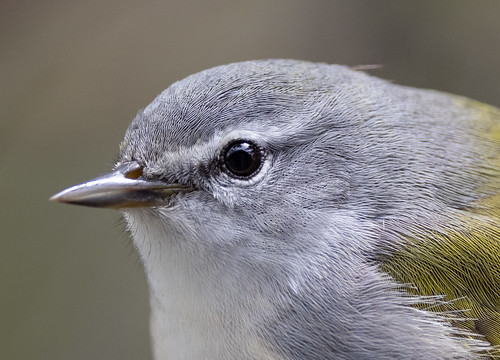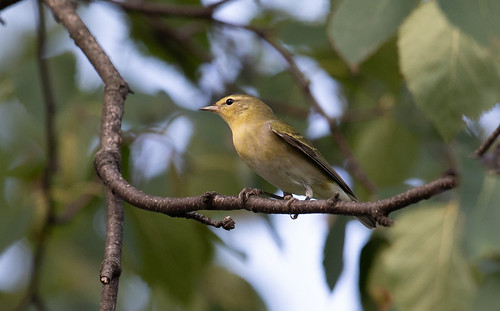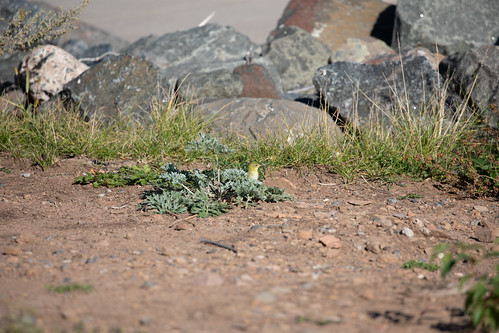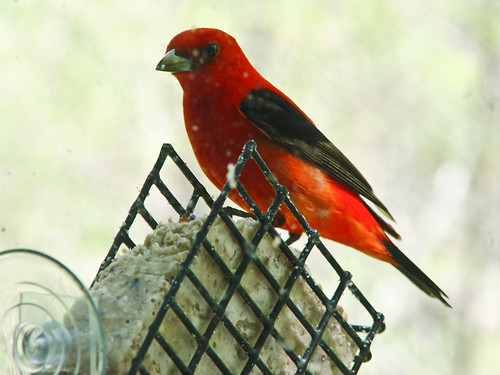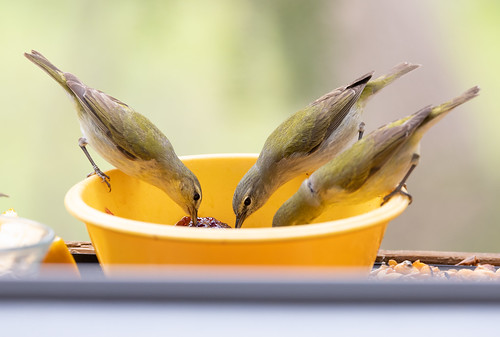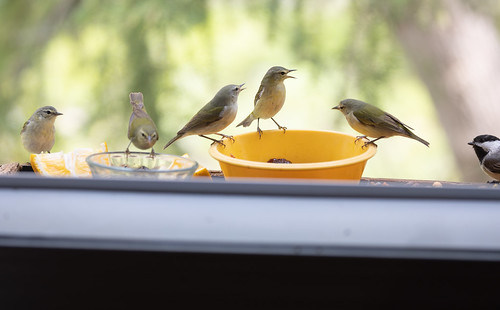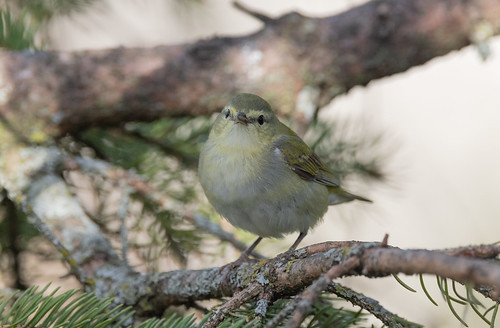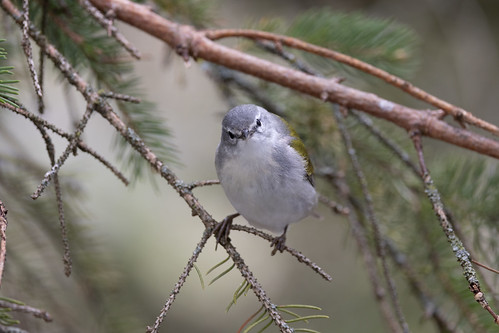One bird I’ve seen every single year that I’ve been a birder but pay little attention to except to list it during warbler migration is the Tennessee Warbler. It’s among the tiniest within a family of tiny birds, weighing about double the weight of a Ruby-throated Hummingbird but 20 or 30 percent less than a chickadee.
Bird books don’t focus on the Tennessee Warbler much except regarding identification. It’s easily confused with the Orange-crowned Warbler and beginners may also confuse it with vireos.
 |
| Tennessee and Orange-crowned Warbler pages from my ABA Field Guide to the Birds of Minnesota |
Its 3-part song is one of the longest and loudest of warbler songs, and easy enough to learn that I figured it out my second year of birding, before I recognized hardly any other bird songs. Part of the Tennessee Warbler song is higher frequency than I can hear nowadays, but enough of the song is within my hearing range that I notice it even without my hearing aids.
Birders count birds that we hear even if we don’t see them. Except on the most competitive Big Days, just about anyone who hears a Scarlet Tanager, Blackburnian Warbler, or any other brilliant singer will take at least a moment to try to see it, but hardly anyone bothers to look for a singing Tennessee Warbler, even when we’re moseying.
I saw my first Tennessee Warbler on September 3, 1975—Russ and I spent Labor Day weekend visiting his parents up in Port Wing, Wisconsin, where I added 13 species to my life list. The most memorable thing about the Tennessee was that it was #100—a milestone species—but the intensity of seeing so many new birds in a short time blurred my memories. It’s impossible to savor one lifer when a dozen more are flitting about. And the little Tennessee was too busy living its own life to squander energy trying to grab my attention.
This year, Tennessee Warblers have been impossible for me to ignore. With our unusually cold spring, trees were barely starting to leaf out as the fourth week of May began. Warblers normally fuel their migration on the tiny caterpillars that hatch right as leaves are opening, and this year that natural food was hardly available at all when a great many warblers were arriving.
Most warblers are entirely insectivores, but a few species, such as the Cape May and Tennessee Warblers, add nectar and fruits to their menu in the tropics, and may also dine on sweeter fare during migration. I've watched Tennessee Warblers picking into the cherries on Russ's trees in August and on mountain ash berries in September.
In the spring of 2004, a late one like this year, I was shocked to see Scarlet Tanagers eating suet. That was when I learned that Cape May Warblers may come to feeders for suet, oranges, sugar water, and grape jelly.
This time around, in addition to Scarlet Tanagers ...
... and Cape May Warblers...
... I've had a much rarer Summer Tanager spending several days visiting my oriole feeders...
...and as many as 40 Tennessee Warblers coming to my feeders as well. By May 28, they outnumbered the Cape Mays in my office window feeder. And this year I have a way better camera than I did in 2004.
It’s fun to see such tiny warblers, with their dainty, aerodynamic little heads, sitting near a big-headed chickadee, like scrawny football fans standing next to the padded and helmeted quarterback.
Chickadees are well-known to be intelligent, but warblers are much smarter and more adaptable than most people realize. They have to be to figure out how to eke out a living when they're on their own during their very first migration, leaving the quiet boreal forest, the only world they’ve ever known. To get to the tropics, they must pass through all kinds of strange habitats. For starters, every single Tennessee Warbler must cross I-90, I-80, and I-10. If after a long, wearying nocturnal flight they find themselves in the middle of Minneapolis or Chicago or an Iowa cornfield, they have to figure out how to find food and safe resting spots or they’re doomed. They're drawn to the calls of chickadees, the one familiar sound they recognize in such strange places. But even without chickadees, they usually figure out what they need to do to get through another day.
Back when I was rehabbing wild birds, I was constantly struck by how quickly warblers adapt to temporary captivity. So I wasn’t surprised that the warblers visiting this spring quickly figured out that behind the window, I was just part of the landscape. Whenever starlings fly to the window feeder, I charge up to the window and wave my hands to get them to fly off. Chickadees ignore that, and the Tennessee Warblers took their cues from them. They did fly off when I opened the lower pane to replenish the feeder but returned the moment I closed window. I open the upper pane to photograph birds in the nearby trees, and this past week I got the loveliest as well as closest photos of Tennessee Warblers I’ve ever taken.
These dainty, quietly winsome birds have been such a constant presence for over a week that I’ll be sad when they move on. They’re headed for boreal forest, mostly in Canada but also northern Minnesota and Wisconsin, where their reproductive success is tied to natural spruce budworm population cycles. Our short-sighted forestry methods to control these insects have led to declines in Tennessee Warbler populations, along with those of Cape May and Bay-breasted Warblers and Evening Grosbeaks. Tennessee Warblers are abundant enough that their population losses are not a major concern to conservationists, especially compared with other declining species, but then again, people once thought Evening Grosbeaks were too abundant to disappear, too.
